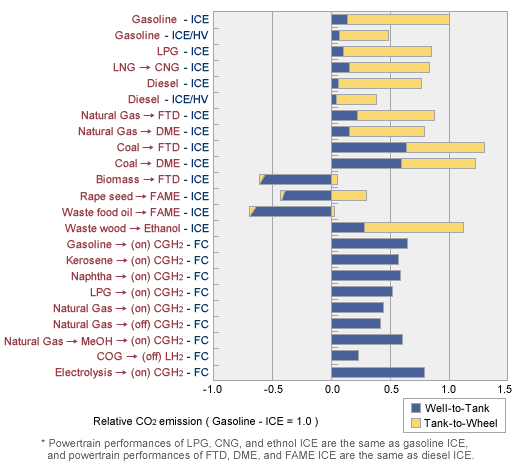Well-to-Wheel Analysis of Greenhouse Gas Emissions of Automotive Fuels in the Japanese Context - Well-to-Tank Report -
November 30, 2004
Toyota Motor Corporation
Mizuho Information & Research Institute, Inc.
Reseach Report (PDF)
Outline of Study
This study focused on estimating well-to-tank energy consumption, greenhouse gas (GHG) emissions and the energy efficiency of current and near-future automotive fuels in Japan. The results of this study were subsequently combined with data related to tank-to-wheel studies previously conducted by TMC, and a case study showing well-to-wheel GHG emissions under fixed conditions, calculated using sedan-type vehicles.
Example of calculation of well-to-wheel GHG emissions

Glossary
ICE: Internal Combustion Engine
LNG: Liquefied Natural Gas
FTD: Fisher-Tropsch Diesel oil
FAME: Fatty Acid Methyl Ester
CGH2: Off-site Compressed Hydrogen (Off)
MeOH: Methanol
GHG: Greenhouse Gas
LPG: Liquefied Petroleum Gas
CNG: Compressed Natural Gas
DME: Dimethyl Ether
CGH2: On-site Compressed Hydrogen (On)
LH2: Off-site Liquefied Hydrogen
COG: Coke-Oven Gas
76 Fuel Pathways Considered
Regarding well-to-tank studies, the 76 fuel pathways considered, broken down into six categories, were: 1) 21 petroleum-based fuels, 2) 20 natural gas-based fuels, 3) eight coal-based fuels, 4) 19 biomass resource-related fuels (three bio-diesel fuels, 10 dry biomass-based fuels and six wet biomass-based fuels), 5) power grid mix (Japan average) and 6) hydrogen production through electrolysis (six byproduct hydrogen pathways). No fixed timeframe was set for the data collected, with efforts focused on understanding and organizing existing data. Additionally, in order to ensure data impartiality, efforts were made to improve credibility by seeking varied advice, ranging from third-party evaluations by specialists (Advisory Committee) to obtaining calculation methods from the data sources. Moreover, where data used in calculation had a broad range, the range is indicated through minimum to maximum values.
Drawing Conclusions and Problems of Comparison
For well-to-wheel studies, and in concurrence with previous research for the 10-15 test cycle (example of calculations are made in this study), which is mainly a comparatively low-speed run, significantly superior results were obtained for hybrid-electric vehicles (gasoline, diesel) in relation to GHG emissions. For synthetic fuels, such as Fischer-Tropsch diesel oil, dimethyl ether (DME) and hydrogen, large variations in well-to-tank GHG emissions were apparent depending on the primary energy used as feedstock, and it is clear that an important aspect of future considerations will be the production of fuels through low GHG emission pathways. Regarding hydrogen, during transition, hydrogen derived from fossil fuels, such as natural gas, has also shown results similar to that of hybrid electric vehicles, and depending on trends in CO2 capture and storage, possibilities of further reductions in GHG emissions with these pathways are conceivable. In addition, fuels derived from biomass resources have comparatively low GHG emission values, and future utilization is anticipated.
The credibility and applicability of calculations in this study depends greatly on calculation preconditions, such as implemented load distribution methods and quality of data. In reality, some fuels, such as petroleum products, city gas, liquefied petroleum gas (LPG) and electricity, are already in industrial use, while biomass resources, synthetic fuels, hydrogen and so on, are still in the early stages of technological development. In addition, even where calculation results of this study are based on actual values?as there is a high degree of uncertainty concerning future technological innovation, market size, new laws and regulations and such?many problems exist concerning the simple comparison of these fuels.
Regarding load distribution between main products and co-products/ byproducts?although this study has been conducted under the premise that, in principle, byproducts will be disposed of?the usage of certain byproducts has been considered in prior studies, although the possibility of realizing this usage is unclear (load distribution considerations). Also, regarding the sphere of the system, the environmental load from the production process of byproduct hydrogen feedstock, such as coke-oven gas (COG), was not taken into consideration during this study.
For these reasons, the calculation results of this study are not unlike preliminary approximations, and in order to contribute further to the initial objectives, the consistency of preconditions and the accuracy of data used in calculations must be improved, and the credibility of the results must be enhanced.
Future Considerations
In the future, these results of well-to-tank analysis will be combined with various tank-to-wheel analysis results and basic data, and various further analyses are scheduled in relation to overall efficiency?from extraction of primary energy to the actual vehicle fuel consumption of well-to-wheel. At such time, it may also become necessary to modify or adjust the calculation results of this study in order to comply with analysis preconditions.
Well-to-wheel analysis results will be an important factor in the selection of future technologies and fuels. However, the technologies and fuels that will be implemented in the future will not be determined by this factor alone. This is because a variety of other factors such as cost, infrastructure and completeness of the technology and its supply potential and usability will also be taken into consideration. In the future, it will be necessary to seek out optimum vehicle/fuel combinations according to energy circumstances, available infrastructure and regulations that apply in each country or region.